The Wind Waits For No One: Nı̨hts’ı Dene Ası̨́ Henáoréhɂı̨́le Ǫt’e: Spirituality in a Sahtúgot’ı̨nę Perspective
Fibbie Tatti’s thesis explores Sahtúgot’ı̨nę spirituality: it describes and defines spirituality “from the perspective of the Sahtúgot’ı̨nę, distinguishing spirituality from concepts such as worldview, culture, and medicine power” (iii, abstract). Spirituality is an essential component of Dene education, Tatti writes. In documents like the Dene Kedǝ curriculum (1993) inclusion of spirituality (which makes up one quarter of the curriculum, along with relationships with land, people, and self) is important but difficult, because spirituality is different for different Indigenous peoples, and means different things.
Teaching on the land, for the Sahtúgot’ı̨nę, is paired with ceremony: feeding the fire, for example. Ceremonies are still practiced but gradually less understood, in part due to language loss. Each ceremony must be contextualized by history an, and the Elders explain this in a language that fewer and fewer youth can understand. Tatti also emphasizes the distinctions between worldview, culture, and spirituality, emphasizing a dependent relationship with animals and the cosmos—this fundamental relationship guides Dene behaviour, laws, and epistemology.
From Abstract:
The Sahtúgot’ı̨nę have lived in the Sahtú Region around Great Bear Lake since time immemorial. Our Elders believe that spirituality is the foundation for our language, culture and worldview and that it is essential for our language and culture to be taught in the context of spirituality. This thesis provides a description and a definition of spirituality from the perspective of the Sahtúgot’ı̨nę, distinguishing spirituality from concepts such as worldview, culture and medicine power. In keeping with our traditional ways of preserving and transmitting knowledge to future generations, the paper relies heavily on stories passed on to us from our Elders. The paper elaborates on key concepts of Sahtúgot’ı̨nę spirituality. First, like human beings, all animals on this earth have a living spirit or bets’ı̨nę́. Other entities on this earth - plants and trees, the water and the wind - are also living beings with their own yǝ́dı́ı. Specific geographic sites with a special significance to the Sahtúgot’ı̨nę are also said to be yǝ́dı́ı. The other key concept is the existence of three dimensions of existence and their inter-relationship which is crucial to the understanding of Sahtúgot’ı̨nę spirituality.
Read other University of Victoria Language Revitalization MA Theses from Susan Saunders and Laura Tutcho.
Access this Resource:
The University of Victoria has made this thesis available for free here: http://hdl.handle.net/1828/6113
Tatti, Fibbie. The Wind Waits For No One: Nı̨hts’ı Dene Ası̨ ́ Henáoréhɂı̨ ́le Ǫt’e: Spirituality in a Sahtúgot’ı̨nę Perspective. Master’s Thesis, University of Victoria, 2015.
Re/mediation: The Story of Port Radium
From Abstract:
This dissertation applies Rob Nixon’s argument that “arresting stories, images, and symbols” are required to draw attention to the slow violence of environmental degradation (Slow Violence and the Environmentalism of the Poor 3) to an extended case study of the way in which narratives in various forms, media, and genres have disseminated and legitimated one Indigenous community’s claims about the violence wrought by uranium mining on their land. The case study on which the project centers is the fifty-year campaign undertaken by members of the community of Déline, Northwest Territories to obtain recognition of and remediation for the environmental, cultural, and psychological risks and damages of federally-mandated uranium mining on Great Bear Lake. Like previous scholarship on risk definition, environmental justice, and the environmentalism of the poor, this study draws out the ways in which conflicts over risk definition give rise to environmental injustice. Like some of this scholarship, it highlights the importance of narrative to legitimating officially discounted risk definitions. The study builds on existing scholarship by adding the variable of cross-cultural, multiple-media adaptation into the equation, arguing that adaptations can alter dominant perceptions of risk even as they alter the discounted risk perceptions they support. Re/mediation, the term the project coins to convey this process of restoring legitimacy to marginalized narratives through mediation, is thus offered as a problematic but ultimately effective riposte to slow violence and its attendant environmental injustices. This project is only the second book-length work on the case study at hand, and the first to analyze textual representations of it across multiple media.
Access this Resource:
Queen's University has made this resource available upon request at the following link: http://hdl.handle.net/1974/13510
Fletcher, Alana. Re/mediation: The Story of Port Radium. Doctoral Thesis, Queen’s University, 2015.
Drum Songs: Glimpses of Dene History
Drum Songs is a largely chronological presentation of Dene history, weaving oral history with archeological evidence and written history. From over 7000 years ago until today, Abel moves through the formation of the Athapaskan language family, early Dene lifestyles, the fur trade, oil, Treaties 8 and 11, and contemporary land claims.
Description:
The Dene nation consists of twelve thousand people speaking five distinct languages spread over 1.8 million square kilometres in the Canadian subarctic. In the 1970s and 1980s, the campaign against the Mackenzie Valley pipeline, support for the leadership of Georges Erasmus in the Assembly of First Nations, and land claim negotiations put the Dene on the leading edge of Canada's native rights movement. Drum Songs reconstructs important moments in Dene history, offering a sympathetic treatment of their past, the impact of the fur trade, their interaction with Christian missionaries, and evolving relations with the Canadian federal government. Using a wide range of sources, including archival documents, oral testimony, archaeological findings, linguistic studies, and folk traditions, Kerry Abel shows that previous ethnocentric interpretations of Canadian history have been excessively narrow. She demonstrates that the Dene were able to maintain a sense of cultural distinctiveness in the face of overwhelming economic, political, and cultural pressures from European newcomers. Abel's classic text questions the standard perception that aboriginal peoples in Canada have been passive victims in the colonization process. A new introduction discusses Dene experience since the first edition of the book and suggests how the approach of scholars in this field is changing.
Access this Resource:
Read the Google Book preview.
Abel, Kerry. Drum Songs: Glimpses of Dene History. 2nd ed. Montreal: McGill-Queen’s University Press, 2005.
Sahtú Godé Dáhk’é, Place of Storıes
Deborah Simmons edited this magazine, and Robert Kershaw did art, design, and layout. Alfred Masuzumi was the community liaison.
This edition opens with a syllabics text by Leon Modeste (elder, Délı̨nę), transcribed and translated by Alfred Masuzumi. It is about ways to keep the Dene way of life, courageously, by following Dene laws. The document also includes an overview of a Délı̨nę community housing program, some photographs of Family Literacy Night, and stories about the Spring Hunt. The youth pages have stories about Yamoria, what the Sahtú region and family means to the children writing, and some images of children’s early handwriting. Some students also talk about summer holidays and what it means to be Aboriginal. Submissions were from Délı̨nę, Norman Wells, Fort Good Hope, and Tulı́t’a.
Search for other issues of Sahtú Godé Dáhk’é, Place of Storıes on this database.
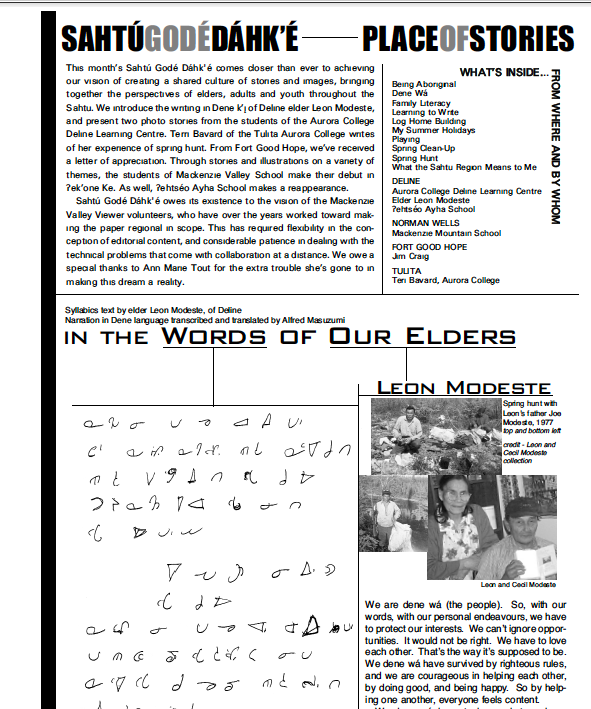
Access this Resource:
Download a PDF of this issue by clicking on the attachment at the bottom of the webpage.
“Sahtú Godé Dáhk’é, Place of Storıes” no. 6, Spring. Supplement to Mackenzie Valley Viewer, Fort Good Hope, 2001.
Sahtú Godé Dáhk’é, Place of Storıes
Deborah Simmons edited the newsletter and Robert Kershaw did art, design, and layout. Alfred Masuzumi was the community liaison.
Henry Tobac’s poetic journal forms a considerable portion of this edition. Henry Tobac is from Fort Good Hope, and wrote a number of poems that explore the Human, Dene experience from 1995 to 2001.
The youth pages at the end of the document are filled with ideas about what students want to be when they grow up. Aspirations include being: a pro NHL player, a rap artist, a model, a police officer, a game designer, and a teacher. There are also many stories and illustrations with family scenes showing young Dene pictures of everyday life.
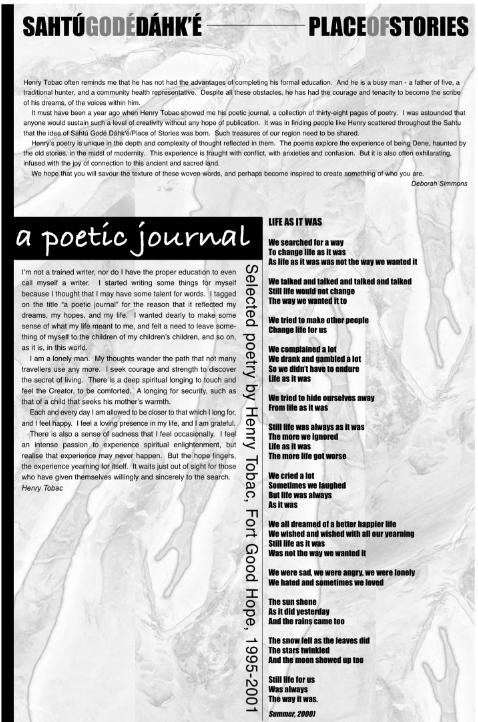
Access this Resource:
Download a PDF of this issue by clicking on the attachment field at the bottom of the page.
“Sahtú Godé Dáhk’é, Place of Storıes” no. 5, Henry Tobac Poetry. Supplement to Mackenzie Valley Viewer, Fort Good Hope, 2001.
Sahtú Godé Dáhk’é, Place of Storıes
This edition focuses on Caribou, with submissions largely from Fort Good Hope and Délı̨nę, and stories from all ages (including a designated section for youth contributions). Editor Deborah Simmons, Design and Layout Robert Kershaw, Community Liaison Afred Masuzumi. Submissions include:
Adele Adgi, Oral Narrative. (About seasonal hunting and traveling)
Pauline Lacou, Oral Narrative, Fort Good Hope. (About uses of moose and caribou hide)
William Sewi, Délı̨nę Elder (Recorded, translated, and transcribed by Alfred Masuzumi) Éfę́ Deyúe Ɂehdaralǝ, When Carıbou Changes ıts Clothes and Éfę́ Gulı́, The Fate of Carıbou.
There is also a note about a source of at least some of the oral histories. The Committee for Original People’s Entitlement (COPE) Oral Narratives Collection has recordings mostly taken from the 1960s and 1970s, in cooperation with CBC in Inuvik.
Further contents include some traditional ways to cook Caribou and some information about what nutrition you can get from different types of the animal. This is followed by the youth pages, wherein students’ stories, poems, and illustrations about Caribou bring the document to a close.
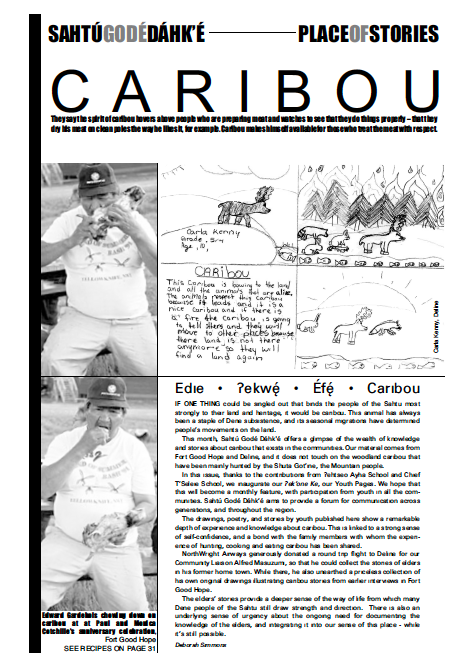
Access this Resource:
Download a PDF of this issue by clicking on the attachment at the bottom of the page.
“Sahtú Godé Dáhk’é, Place of Storıes.” Theme, Caribou, Edıe, ɂekwę́, Éfę́. Supplement to Mackenzie Valley Viewer, Fort Good Hope, 2001.
Sahtú Godé Dáhk’é, Place of Storıes
This document includes writing contest submissions from Fort Good Hope, Délı̨nę, and Norman Wells, with illustrations from students of Chief T’Selehye and Colville Lake schools. The contest was lead by principal of Chief T’Selehye school, Gayle Strikes With a Gun. Editor Deborah Simmons, Design and Layout Robert Kersahw, Community Liaison Alfred Masuzumi.
Stories include:
Gabriel Tobac. Living in Fort Good Hope, NT. (FGH – English_
Lorraine Garedeboid. How I Live. (FGH – English)
Tahti Bayha. Mystory. (Délı̨nę, FGH)
…and many more from all school grades, in English, about the experiences authors have had in their homes and on the land. A few students also wrote scary stories for the contest, about hauntings and ghosts. There are also many stories and poems from adults about Dene legends, old stories, and experiences that taught them lessons.
Some stories that include Dene language are:
Dominique Tobac, Elder, Fort Good Hope. Translated and transcribed by Alfred Masuzumi. Syllabic Text: Famine. (About a family surviving famine)
Georgina Tobac. Syllabic Text, translated and transcribed by Addy Tobac. The Human Spirit. (About the importance of traditional teaching)
Search for other issues of Sahtú Godé Dáhk’é, Place of Storıes on this database.
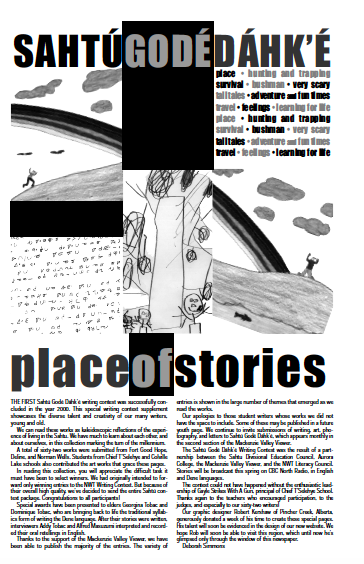
Access this Resource:
Download a copy of this issue by clicking on the attachment at the bottom of this page.
“Sahtú Godé Dáhk’é, Place of Storıes.” Special Writing Contest Edition. Supplement to Mackenzie Valley Viewer, Fort Good Hope, 2001.
The people of Denendeh: Ethnohistory of the Indians of Canada's Northwest Territories
Book description:
For fifty years anthropologist June Helm studied the culture and ethnohistory of the Dene, “The People,” the Athapaskan-speaking Indians of the Mackenzie River drainage of Canada's western subarctic. Now in this impressive collection she brings together previously published essays—with updated commentaries where necessary—unpublished field notes, archival documents, supplementary essays and notes from collaborators, and narratives by the Dene themselves as an offering to those studying North American Indians, hunter-gatherers, and subarctic ethnohistory and as a historical resource for the people of all ethnicities who live in Denendeh, Land of the Dene.
Helm begins with a broad-ranging, stimulating overview of the social organization of hunter-gatherer peoples of the world, past and present, that provides a background for all she has learned about the Dene. The chapters in part 1 focus on community and daily life among the Mackenzie Dene in the middle of the twentieth century. After two historical overview chapters, Helm moves from the early years of the twentieth century to the earliest contacts between Dene and white culture, ending with a look at the momentous changes in Dene-government relations in the 1970s. Part 3 considers traditional Dene knowledge, meaning, and enjoyments, including a chapter on the Dogrib hand game. Throughout, Helm's encyclopedic knowledge combines with her personal interactions to create a collection that is unique in its breadth and intensity.
Access this Resource:
Helm, June, with contributions by Teresa S. Carterette and Nancy S. Lurie. The people of Denendeh: Ethnohistory of the Indians of Canada’s Northwest Territories. Iowa City: University of Iowa Press, 2000.
Read the Google Books Preview:
Language in the Northwest Territories and the Yukon Territory
Harnum provides a brief history of and context for Indigenous languages in the NWT and Yukon Territory, as well as colonial governance and its history in the north, before turning to historical languages and shift (for example, the gradual erosion of the distinction between Yellowknives Dene and their neighboring languages and cultures). Next, the author turns to contemporary trends in the NWT legislature, curriculum development, and training programs.
Access this Resource:
Harnum, Betty. “Language in the Northwest Territories and the Yukon Territory.” In Language in Canada, edited by John Edwards, 469-82. Cambridge: Cambridge University Press, 1998.
Read Harnum's chapter in the Google Book Preview:
Medicine Power Ɂı̨́k’ṕ Įk’ǫǫ́
This book contains Dene Medicine Power Stories in English, with translations. Many of the stories are about Cheely, K’áhbamı Túé, a Caribou medicine power man who was a Caribou in a former life, reincarnated, but was still able to communicate with the Caribou in order to make sure that people would not starve. There are stories about Yamoria and his brother, and Edzo making peace between the Dogrib and Chipewyan. One very interesting story is Yamoria giving the Dene their laws. Another has to do with a man named Daoyee and how he got his medicine power, not too long ago. Many of the stories have to do with the use of medicine power and the importance of only using it to help people.
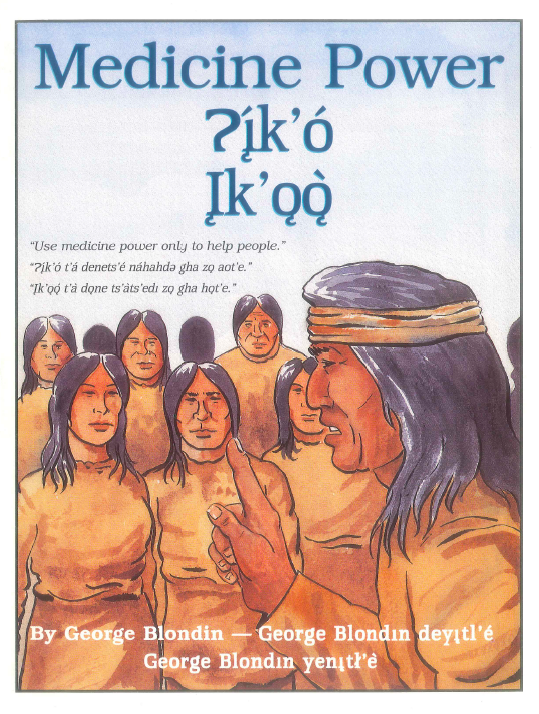
Access this Resource:
The Dene Cultural Institute (now Yamozha Kue Society) can be contacted through its Facebook Page.
Blondin, George. Medicine Power Ɂı̨́k’ṕ Įk’ǫǫ́. Dene Cultural Institute, 1996.
Illustrated by Wally Wolfe, Edited by Aggie Brokman, North Slavey Translation by Dora Grandjambe, Dogrib Translation by Violet Mackenzie and Philip Rabesca.


 Phone: 867-374-4040
Phone: 867-374-4040 Email:
Email: